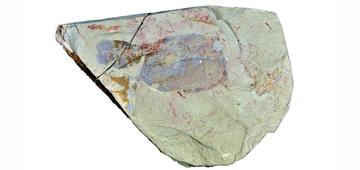Animal Origins
A major research theme at the Oxford University Museum of Natural History focused on the origin and early evolution of major animal groups
About the research theme
The late Ediacaran–Cambrian (~571 to 485 million years ago) was a period of immense change in the Earth’s biosphere. Animals appeared and diversified for the first time, alongside a backdrop of major environmental upheaval. Research at the Museum seeks
to unravel the pattern and process underlying the origin and early evolution of major animal groups and the emergence of modern oceanic ecosystems.

The enigmatic Vetulicola from the Chengjiang biota, China
Museum researchers have particular expertise in the palaeobiology, taphonomy and geology of sites of exceptional preservation. These include: Mistaken Point, Newfoundland, Canada, which is known for fossils recording the oldest large and structurally
complex organisms on Earth; Sirius Passet, North Greenland, which provides a unique perspective on the evolution of several important animal groups; and the Chengjiang biota, Yunnan Province, China, which preserves the most complete record of an early
Cambrian marine community. Research at the Museum was instrumental in a successful bid to have the Chengjiang biota designated a UNESCO World Heritage site in 2012.
Researchers in the group use innovative techniques to analyse fossil specimens, localities and geological environments from around the world, often as part of international collaborations. This includes a major partnership with Yunnan University, China:
the International Joint Laboratory for Palaeobiology and Palaeoenvironment, detailed on the Museum of Natural History blog.
Our researchers model biosphere-geosphere interactions across the Ediacaran–Cambrian transition to elucidate the drivers of the early evolution of animal body plans, drawing upon both palaeobiological and geochemical records. High-resolution tomographic
techniques are used to reconstruct the anatomy of exceptionally-preserved fossils digitally and in three dimensions. Additionally, cutting-edge computer simulations are used to quantify the functional performance of enigmatic extinct organisms. These
data, along with more traditional palaeontological techniques, are allowing us to test hypotheses concerning the ecology and early evolutionary history of animals across the tree of life.
Research in this theme is featured in a new exhibition at the Oxford University Museum of Natural History, First Animals, which explores the strands of evidence for Earth’s mysterious
early animals.
Research team
- Dr Frances Dunn
- Dr Jack Matthews
- Dr Duncan Murdock
- Dr Imran Rahman
- Professor Derek Siveter
- Professor Paul Smith
Key research publications
- Gibson, B. M., Rahman, I. A., Maloney, K. M., Racicot, R. A., Mocke, H., Laflamme, M. & Darroch, S. A. F. 2019. Gregarious suspension feeding in a modular Ediacaran organism. Science Advances, 5, eaaw0260. DOI: 10.1126/sciadv.aaw0260
- Hammarlund, E. U., Smith, M. P., Rasmussen, J. A., Nielsen, A. T., Canfield, D. E. & Harper, D. A. T. 2019. The Sirius Passet Lagerstätte of North Greenland—A geochemical window on early Cambrian low ‐ oxygen environments and
ecosystems. Geobiology, 17, 12–26. DOI: 10.1111/gbi.12315 - Hou, X., Siveter, David J., Siveter, Derek J., Aldridge, R. J., Cong, P., Gabbott, S. E., Ma, X., Purnell, M. A. & Williams, M. 2017. The Cambrian fossils of Chengjiang, China: The flowering of early animal life. 2nd edition.
Wiley, Oxford, 308 pp. - Liu, A. G., McMahon, S., Matthews, J. J., Still, J. W. & Brasier, A. T. 2019. Petrological evidence supports the death mask model for the preservation of Ediacaran soft-bodied organisms in South Australia. Geology, 47, 215–218.
- Park, T.-Y. S., Kihm, J.-H., Woo, J., Park, C., Lee, W. Y., Smith, M. P., Harper, D. A. T., Young, F., Nielsen, A. T. & Vinther, J. 2018. Brain and eyes of Kerygmachela reveal protocerebral ancestry of the panarthropod head. Nature
Communications, 9, 1019. DOI: 10.1038/s41467-018-03464-w - Purnell, M. A., Donoghue, P. C. J., Gabbott, S. E., McNamara, M. E., Murdock, D. J. E. & Sansom, R. S. 2018. Experimental analysis of soft ‐ tissue fossilization: opening the black box. Palaeontology, 61, 317–323. DOI: 10.1111/pala.12360
Find out more
Click here to find out more about the Animal Origins on Museum of Natural History's website



